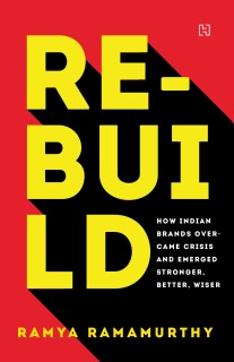Review: Re-build by Ramya Ramamurthy
A storybook on brands that went topsy-turvy but fought on through crises is a compelling read

No, the hyphen in the single-word cover title isn’t a typo. It’s there to assert that this book is as unique as the brands it talks about.
Curiously, Ramya isn’t a brand executive. She’s described as a storyboard creator busily tracking the advertising and marketing ups and downs of soft media products created for TV channels like Star World and National Geographic.
Brands comprise a congested part of business literature. But Ramya has spotted a vacant niche and authored a compelling storybook, not a ponderous textbook, on brands that went topsy-turvy but fought. Only Indian brands (some are US-owned) are covered, but with as many as 21 well-researched tales told of “how these brands overcame crises and emerged stronger, better, wiser” that shortcoming doesn’t count.
Ramya might not agree but I see brands as human beings. They are conceived, born, nurtured, cared for when knees get bruised, marched through grow-up-strong drills, recognised as adults and let into a big bad competitive world by loving, tense parents. Some survive hard knocks, some don’t. Ramya favours those who do.
“Crisis” is the defining word in the author’s absorbing narrative and the very first paragraph says so. “It may seem incendiary to start off a book about the business of branding and marketing by suggesting that every brand is a crisis in waiting... The very existence of a brand doesn’t necessarily mean that a crisis will occur but the possibilities of one happening are far too real to ignore.”
In a free market, potential fuses crowd around brands. It’s futile for brand owners to be paranoid about lurking dangers but their awareness levels must be high and backup plans ready to tackle emergencies they pray won’t be as cataclysmic as the Bhopal gas tragedy (1984) when deadly methyl isocyanide leakage killed thousands or the devastating Bombay High blaze (2005) in the Arabian Sea that destroyed an Indian oil rig worth ₹9,000 crores and spilt 120,000 barrels of crude.
Is it okay if Crises spelt with capital C aren’t provided for? Ramya’s analyses show it isn’t. When brands are mauled owners face financial, market share, goodwill and loss-of-face costs adding up to a tidy sum. It is expensive to rebuild an injured brand. Major factors and several subsidiary ones mesh to create this book’s contents.
Let’s pick three of 21 famous brands. Since 1947, Cadbury’s chocolate has enjoyed “a remarkably positive brand image” per Ramya’s understatement. On 3 October, 2003, a consumer in Mumbai complained to the government that two bars of Dairy Milk chocolate bought from a local shop were worm-infested. The media went ballistic. The minister visited the factory and gave Cadbury a clean chit. The very next day, the minister said hygienic production wasn’t enough, retail-storage hygiene too was Cadbury’s responsibility. Within a week, the sales volume of Cadbury products plummeted from 70 to 30 per cent! Emergency brand repair commenced in crisis mode. Ramya describes Cadbury’s subsequent survival story.
Everyone knows Unilever is India’s largest FMCG company. From 1987 to 2001, it owned and ran one of the world’s largest thermometer factories in a residential area of Kodaikanal bordered by a watershed forest. It manufactured 163 million thermometers annually consuming 900 kg of mercury. In March 2001, the Pollution Control Board found hazardous waste rules had been violated. An appalled Unilever adopted the denial, closure, and litigation mode. This collapsed when rap song “Kodaikanal Won’t” created by an NGO went viral with 4 million views.

Litigation lasted 15 years, ending with “settlement of an undisclosed sum” to 511 workers. Ramya gives a detailed account of gritty Unilever’s ultimate compromise.
Read more: Past perfect: Why luxury brands are investing heavily in heritage
Let’s quickly run through US-owned Kodak’s inability to grasp the threat from digital technology. What went wrong at Kodak? Both photographers and movie theatres moved to digital; film-rolls sales nosedived vertically; retail shelf-space shrank; an astonishing procession of 16 CEOs shuffled in and out; analogue surrendered to digital. 124 year-old Kodak exited its legacy business, sold off patents and filed for bankruptcy in 2012.
Another 18 brands grip Ramya’s book. Read it!
Sujoy Gupta is business historian and corporate biographer






